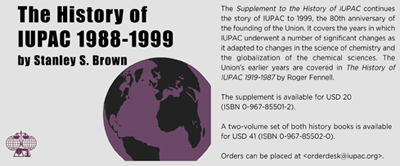|
|
Vol.
27 No. 6
November-December 2005
| IUPAC Wire |
| |
News and information on IUPAC, its fellows, and members organizations
See also www.iupac.org/news |
Fullerene Nomenclature—An Addendum to IUPAC History
A Letter from Stanley S. Brown
The
note about fullerenes in the Sept.-Oct. 2005 CI (p.
28) prompts me to follow up on your feature in the previous
issue, July-Aug. CI (pp. 10–12). I enjoyed
your account of processing the IUPAC archives, having spent
many hours with them at the Oxford Secretariat in preparing
the Supplement
to the History of IUPAC 1988–1999.
The penultimate draft of the supplement included a small section on fullerenes as follows:
11.6.4 Fullerene Nomenclature*
Vice-President Bard, having expressed concern that the Union should take quicker action about nomenclature for newly emerging areas, and with the fullerenes in mind, promptly convened a Working Party, with input from the Commissions on Nomenclature of Inorganic Chemistry and of Organic Chemistry and from the Commission on High Temperature and Solid State Chemistry. He expressed the hope to the Executive Committee (Dublin, 1992) that the work could be undertaken by correspondence during 1992, together with one meeting in 1993, so that draft recommendations on nomenclature could be available within two years.
Progress was duly reported to the Bureau (Oxford, 1992) and to the Executive Committee (Newark, 1993), and IDCNS acted swiftly to review the Working Party’s draft recommendations. However, the Executive Committee (Oxford, 1994) and Bureau (Antwerp, 1994) learned that the American Chemical Society’s Chemical Abstracts Service was already formulating a somewhat different approach to fullerene nomenclature. Strong efforts were made to harmonize the IUPAC and Chemical Abstracts approaches, but Past-President Bard had to admit to the Executive Committee (Reading, 1995) that his attempt to rapidly develop systematic fullerene nomenclature was a failed experiment. It was clear that IUPAC needed to act at the very earliest stages of newly emerging fields of chemistry. The Executive Committee (Oxford, 1996) recommended that revised recommendations from the Working Party should be published as an interim report, but this outcome was criticized in the Bureau (Oxford, 1996) as being the result of the ad hoc way in which the work had been initiated within the Union. Nevertheless, the Executive Committee (Jerusalem 1997) was advised that the project had been completed and a report was in press. The Committee agreed that future policy and procedures regarding chemical nomenclature should be included in topics to be addressed by the Strategy Development and Implementation Committee.
This section was edited out of the final script. It would surely be a pity if the background to the fullerene problem were to be overlooked!
*Section 11 is titled “Restructuring, Reorientation, Relocation: 1988-1999” and subsection 11.6 is titled “Nomenclature and Symbols.”

Page
last modified 28 October 2005.
Copyright © 2003-2005 International Union of Pure and
Applied Chemistry.
Questions regarding the website, please contact [email protected]
|